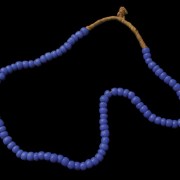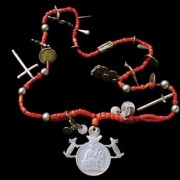Guatemala’s Unique Chachales
There are not a lot of words that have crossed over from Guatemala’s 22 indigenous languages into Spanish. One that has, huipil, actually comes from Nahua huipilli in Mexico and arrived in the early 16th century with the Nahuatl, who accompanied the Spaniards to Guatemala. A huipil is, of course, a woman’s blouse.
A second word is chachal, Quiché for necklace. The evolution of chachales in Guatemala is a fascinating tale of history, economics and anthropology. At the time of the Conquest, Guatemala’s indigenous prized red coral as component in necklaces. As easily recoverable near-shore coral became scarce, sharp traders, chiefly in Europe, manufactured substitutes and introduced them into Guatemala as trade goods. These were almost but not always red, apparently to satisfy taste here and elsewhere.
Red beads have long held a certain fascination not just here but around the world. As many as 2,000 years ago in early Aleppo in modern-day Syria, red carnelian stones were fashioned into beads worn by donkeys and said to protect the rider from the evil eye. They were subsequently made of red glass. The word morphed into cornaline d’aleppo, and came to Guatemala as perhaps the most famous trade bead that was once in common use in Guatemala.
Still manufactured today, chiefly in the Italian glass-making centers at Murano near Venice, red glass beads with a white center or “heart” made their way into Guatemalan chachales in place of coral. Hudson Bay Trading Company records in Canada show that 1.6 of these beads, also called white hearts, were exchangeable for a single beaver pelt.

Different areas of Guatemala adopted different colors of beads. The most striking example is the town of Patzún, where the indigenous prized and still wear blue beads.
As time went on in Guatemala, different areas of Guatemala adopted different colors of beads. The most striking example is the town of Patzún in Chimaltenango, where the indigenous prized and still wear blue beads, the early ones of which are known to bead collectors as “Patzún blues.” When and how these beads were introduced into and became standard apparel in Patzún is not recorded. (Fascination with blue-eyed Spaniards?) But the earliest Patzún beads would appear to be—judging by their style of manufacture—from the 16th to 18th century.
Another distinctive bead arrived, probably in the 19th century, from Gujarat, India. Called Coca Cola beads by collectors by virtue of their green glass color, these beads were hand fashioned and pierced when hot with a nail, which accounts for the tapered hole in each bead. When beads began to be machine produced in Gablonice in today’s Czech Republic, white beads became popular in Guatemala in the mid to late 19th century. The Gablonice beads, again still manufactured today, are instantly recognizable by the distinct lines that appear on the circle about where the Tropics of Cancer and Capricorn would be on the Earth.
Sharp-eyed collectors can still find early beads in Guatemala, and each necklace tells a tale. It is probably not a constant or original tale of style and bead arrangement, since monofilament line is a recent invention, and beads were strung and restrung constantly. Likewise, as the fortunes of wearers changed, it is reasonable to think that silver was removed to be spent in time of need and added during times of prosperity. Many of the coins found in necklaces today come from an “unfortunate” period of Guatemala’s coinage history. When the government abandoned the silver standard at the turn of the 20th century, it began minting nickel copies of silver coins. When trading nations refused to deal with Guatemala, these beads became essentially worthless and made their way popularly into chachales.
Most of the silver coins passed off today as original are counterfeit. The bubbly surface is the tip-off since early coinage was struck, not poured into a bubble-producing mold.
As the 20th century arrived, mass-produced beads from China and elsewhere came into Guatemala, again most often red in color. In addition, since world travel soared after World War II, beads have made their way from and to strange places, including Africa. Blame the Peace Corps and backpackers for Guatemala’s straying from the traditional coral, red glass and coins.
Note: The author, cited in most bead reference works, wrote the benchmark studies on glass beads in Guatemalan chachales in the late 1970s. If a reader has a question or comment, or would like an opinion on the source and age of a bead, send your photo to gmg977@yahoo.com

Looking for antique chachales necklace. Any suggestions besides Casa de Arte.
I have alot of antique chachales that I have collected over a
period of 30 years. Many coca-cola beads also. Casa de Arte(probably reproductions)
I am from Guatemala, and my grandmother inherited to me five of these chachales, they are really beautiful, and I am selling them. If you know who can buy them, please send me an e-mail.
Jenny please email me at magda.gotts@gmail.com. Thanks.
I WOULD LIKE TO SEE YOUR CHACHALES WRITE ME AND SEND ME PICTURES.
TKS IAM FROM GUATEMALA BUT I LOVE THEM
When I lived in Guatemala in the early 1960s, I collected antique huipiles, cofradia costumes from Chichi, religious paintings on metal, rare Guatemalan coins, and various beaded and antique silver chachales. Since my children are not interested in this collection, I would love to sell them to people or entities that appreciate these treasures. Any idea where I can begin my quest?
Eva I would like to see the chachal you have If you are interested in selling 2reachelizabeth@gmail.com. My husband is going to guate in a few weeks this is one of the items on my list however I’m not so sure he would not come back with a new replica thanks
I have chachale that I need appraised. Any ideas?
I would suggest that you send a photo to gmg977@yahoo.com
Thank you. I’ll do that.